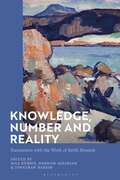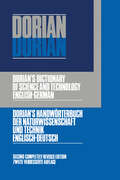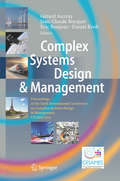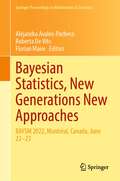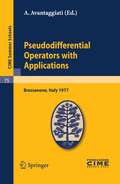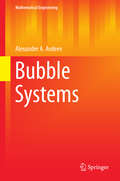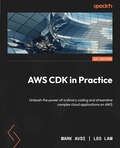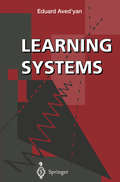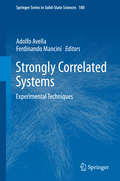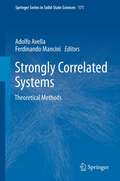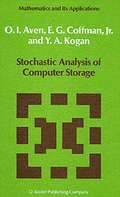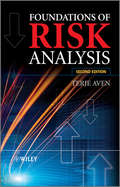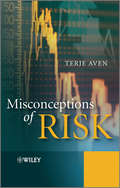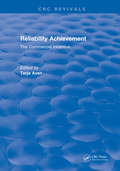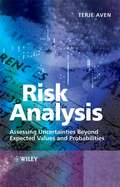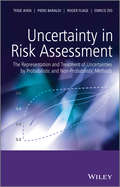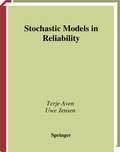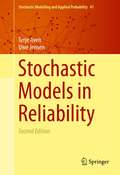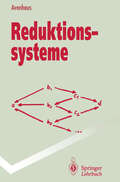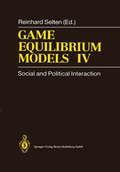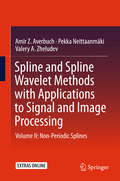- Table View
- List View
Knowledge, Number and Reality: Encounters with the Work of Keith Hossack
by Bahram Assadian Author Editor Nils Kürbis Author Jonathan Nassim AuthorThroughout his career, Keith Hossack has made outstanding contributions to the theory of knowledge, metaphysics and the philosophy of mathematics.This collection of previously unpublished papers begins with a focus on Hossack's conception of the nature of knowledge, his metaphysics of facts and his account of the relations between knowledge, agents and facts. Attention moves to Hossack's philosophy of mind and the nature of consciousness, before turning to the notion of necessity and its interaction with a priori knowledge. Hossack's views on the nature of proof, logical truth, conditionals and generality are discussed in depth. In the final chapters, questions about the identity of mathematical objects and our knowledge of them take centre stage, together with questions about the necessity and generality of mathematical and logical truths.Knowledge, Number and Reality represents some of the most vibrant discussions taking place in analytic philosophy today.
Dictionary of Science and Technology: English-German
by UNKNOWN AUTHORDorian's Dictionary of Science and Technology: English-German, Second Revised Edition focuses on the compilation of terms employed in science and technology. The book first takes a look at abduction, aberration, abhesion, abating, ablation, abscission, coupling, covering, back iron, cross-breeding, clip, cleats, channel, circuit diagram, connection, conveyors, and supercharger. The manuscript then takes a look at dabbing, dacite, dactyl, daffodil, damp, earmark, earphone, ripening, current prospecting, facilities, gaff, gablet, galaxy, gale, gait, gall, and galipot. The publication ponders on haddock, Hadley quadrant, H-bomb, habitation, habituation, hemoglobin, hailstorm, hail, halation, ichnography, iceboat, oblate, oblique, electrode structure, obesity, oatmeal, dyeing, and pachyderm. The text then explores wainscoting, waist, wale, waiver, ultrafilter, ultrahigh frequency, ulocarcinoma, elongation, vaccinal fever, vaccination, vaccine, vacancy, and vacuometer. The text is a dependable source of data for researchers interested in the terms used in science and technology.
Complex Systems Design & Management: Proceedings of the Sixth International Conference on Complex Systems Design & Management, CSD&M 2015
by Gérard Auvray Jean-Claude Bocquet Eric Bonjour Daniel KrobThis book contains all refereed papers that were accepted to the sixth edition of the « Complex Systems Design & Management Paris » (CSD&M Paris 2015) international conference which took place in Paris (France) on November 23-25, 2015.These proceedings cover the most recent trends in the emerging field of complex systems sciences & practices from an industrial and academic perspective, including the main industrial domains (aeronautics & aerospace, defense & security, electronics & robotics, energy & environment, health & welfare, software & e-services, transportation), scientific & technical topics (systems fundamentals, systems architecture & engineering, systems metrics & quality, systems modeling tools) and systems types (artificial ecosystems, embedded systems, software & information systems, systems of systems, transportation systems).The CSD&M Paris 2015 conference is organized under the guidance of the CESAMES non-profit organization, address: CESAMES, 8 rue de Hanovre, 75002 Paris, France.
Bayesian Statistics, New Generations New Approaches: BAYSM 2022, Montréal, Canada, June 22–23 (Springer Proceedings in Mathematics & Statistics #435)
by Alejandra Avalos-Pacheco Roberta Vito Florian MaireThis book hosts the results presented at the 6th Bayesian Young Statisticians Meeting 2022 in Montréal, Canada, held on June 22–23, titled "Bayesian Statistics, New Generations New Approaches". This collection features selected peer-reviewed contributions that showcase the vibrant and diverse research presented at meeting. This book is intended for a broad audience interested in statistics and aims at providing stimulating contributions to theoretical, methodological, and computational aspects of Bayesian statistics. The contributions highlight various topics in Bayesian statistics, presenting promising methodological approaches to address critical challenges across diverse applications. This compilation stands as a testament to the talent and potential within the j-ISBA community. This book is meant to serve as a catalyst for continued advancements in Bayesian methodology and its applications and encourages fruitful collaborations that push the boundaries of statistical research.
Pseudodifferential Operators with Applications: Lectures given at a Summer School of the Centro Internazionale Matematico Estivo (C.I.M.E.) held in Bressanone (Bolzano), Italy, June 16-24, 1977 (C.I.M.E. Summer Schools #75)
by A. AvantaggiatiA. Dynin: Pseudo-differential operators on Heisenberg groups.- A. Dynin: An index formula for elliptic boundary problems.- G.I. Eskin: General mixed boundary problems for elliptic differential equations.- B. Helffer: Hypoellipticité pour des opérateurs différentiels sur des groupes de Lie nilpotents.- J.J. Kohn: Lectures on degenerate elliptic problems.- K. Taira: Conditions nécessaires et suffisantes pour l’existence et l’unicité des solutions du problème de la dérivée oblique.- F. Treves: Boundary value problems for elliptic equations.
Bubble Systems (Mathematical Engineering)
by Alexander A. AvdeevThis monograph presents a systematic analysis of bubble system mathematics, using the mechanics of two-phase systems in non-equilibrium as the scope of analysis. The author introduces the thermodynamic foundations of bubble systems, ranging from the fundamental starting points to current research challenges. This book addresses a range of topics, including description methods of multi-phase systems, boundary and initial conditions as well as coupling requirements at the phase boundary. Moreover, it presents a detailed study of the basic problems of bubble dynamics in a liquid mass: growth (dynamically and thermally controlled), collapse, bubble pulsations, bubble rise and breakup. Special emphasis is placed on bubble dynamics in turbulent flows. The analysis results are used to write integral equations governing the rate of vapor generation (condensation) in non-equilibrium flows, thus creating a basis for solving a number of practical problems. This book is the first to present a comprehensive theory of boiling shock with applications to problems of critical discharge and flashing under the fast decompression conditions. Reynolds’ analogy was the key to solving a number of problems in subcooled forced-flow boiling, the theoretical results of which led to easy-to-use design formulas. This book is primarily aimed at graduate and post-graduate students specializing in hydrodynamics or heat and mass transfer, as well as research expert focused on two-phase flow. It will also serve as a comprehensive reference book for designers working in the field of power and aerospace technology.
Aws Cdk In Practice: Streamline Building Complex Cloud Applications On Aws By Unleashing The Power Of Ordinary Coding
by Mark Avdi Leo LamLearning Systems
by Eduard Aved'yanA learning system can be defined as a system which can adapt its behaviour to become more effective at a particular task or set of tasks. It consists of an architecture with a set of variable parameters and an algorithm. Learning systems are useful in many fields, one of the major areas being in control and system identification. This work covers major aspects of learning systems: system architecture, choice of performance index and methods measuring error. Major learning algorithms are explained, including proofs of convergence. Artificial neural networks, which are an important class of learning systems and have been subject to rapidly increasing popularity, are discussed. Where appropriate, examples have been given to demonstrate the practical use of techniques developed in the text. System identification and control using multi-layer networks and CMAC (Cerebellar Model Articulation Controller) are also presented.
Strongly Correlated Systems: Experimental Techniques (Springer Series in Solid-State Sciences #180)
by Adolfo Avella Ferdinando ManciniThe continuous evolution and development of experimental techniques is at the basis of any fundamental achievement in modern physics. Strongly correlated systems (SCS), more than any other, need to be investigated through the greatest variety of experimental techniques in order to unveil and crosscheck the numerous and puzzling anomalous behaviors characterizing them. The study of SCS fostered the improvement of many old experimental techniques, but also the advent of many new ones just invented in order to analyze the complex behaviors of these systems. Many novel materials, with functional properties emerging from macroscopic quantum behaviors at the frontier of modern research in physics, chemistry and materials science, belong to this class of systems. The volume presents a representative collection of the modern experimental techniques specifically tailored for the analysis of strongly correlated systems. Any technique is presented in great detail by its own inventor or by one of the world-wide recognized main contributors. The exposition has a clear pedagogical cut and fully reports on the most relevant case study where the specific technique showed to be very successful in describing and enlightening the puzzling physics of a particular strongly correlated system. The book is intended for advanced graduate students and post-docs in the field as textbook and/or main reference, but also for any other researcher in the field who appreciates consulting a single, but comprehensive, source or wishes to get acquainted, in a as painless as possible way, with the working details of a specific technique.
Strongly Correlated Systems: Theoretical Methods (Springer Series in Solid-State Sciences #171)
by Adolfo Avella Ferdinando ManciniThe volume presents, for the very first time, an exhaustive collection of those modern theoretical methods specifically tailored for the analysis of Strongly Correlated Systems. Many novel materials, with functional properties emerging from macroscopic quantum behaviors at the frontier of modern research in physics, chemistry and materials science, belong to this class of systems. Any technique is presented in great detail by its own inventor or by one of the world-wide recognized main contributors. The exposition has a clear pedagogical cut and fully reports on the most relevant case study where the specific technique showed to be very successful in describing and enlightening the puzzling physics of a particular strongly correlated system. The book is intended for advanced graduate students and post-docs in the field as textbook and/or main reference, but also for other researchers in the field who appreciates consulting a single, but comprehensive, source or wishes to get acquainted, in a as painless as possible way, with the working details of a specific technique.
Stochastic Analysis of Computer Storage (Mathematics and Its Applications #38)
by O.I. Aven E.G. Coffman Y.A. KoganApproach your problems from the right end It isn't that they can't see the solution. It is and begin with the answers. Then one day, that they can't see the problem. perhaps you will find the final question. G. K. Chesterton. The Scandal of Fother 'The Hennit Clad in Crane Feathers' in R. Brown 'The point of a Pin'. van GWs The Chinese More Murders. Growing specialization and diversification have brought a host of monographs and textbooks on increasingly specialized topics. However, the "tree" of knowledge of mathematics and related fields does not grow only by putting forth new branches. It also happens, quite often in fact, that branches which were thought to be completely disparate are suddenly seen to be related. Further, the kind and level of sophistication of mathematics applied in various sciences has changed drastically in recent years: measure theory is used (non-trivially) in regional and theoretical economics; algebraic geometry interacts with physics; the Minkowsky lemma, coding theory and the structure of water meet one another in packing and covering theory; quantum fields, crystal defects and mathematical programming profit from homotopy theory; Lie algebras are relevant to filtering; and prediction and electrical engineering can use Stein spaces. And in addition to this there are such new emerging subdisciplines as "experimental mathematics", "CFD", "completely integrable systems", "chaos, synergetics and large-scale order", which are almost impossible to fit into the existing classification schemes. They draw upon widely different sections of mathematics.
Foundations of Risk Analysis: A Knowledge And Decision-oriented Perspective
by Terje AvenFoundations of Risk Analysis presents the issues core to risk analysis – understanding what risk means, expressing risk, building risk models, addressing uncertainty, and applying probability models to real problems. The author provides the readers with the knowledge and basic thinking they require to successfully manage risk and uncertainty to support decision making. This updated edition reflects recent developments on risk and uncertainty concepts, representations and treatment. New material in Foundations of Risk Analysis includes: An up to date presentation of how to understand, define and describe risk based on research carried out in recent years. A new definition of the concept of vulnerability consistent with the understanding of risk. Reflections on the need for seeing beyond probabilities to measure/describe uncertainties. A presentation and discussion of a method for assessing the importance of assumptions (uncertainty factors) in the background knowledge that the subjective probabilities are based on A brief introduction to approaches that produce interval (imprecise) probabilities instead of exact probabilities. In addition the new version provides a number of other improvements, for example, concerning the use of cost-benefit analyses and the As Low As Reasonably Practicable (ALARP) principle. Foundations of Risk Analysis provides a framework for understanding, conducting and using risk analysis suitable for advanced undergraduates, graduates, analysts and researchers from statistics, engineering, finance, medicine and the physical sciences, as well as for managers facing decision making problems involving risk and uncertainty.
Foundations of Risk Analysis
by Terje AvenFoundations of Risk Analysis presents the issues core to risk analysis – understanding what risk means, expressing risk, building risk models, addressing uncertainty, and applying probability models to real problems. The author provides the readers with the knowledge and basic thinking they require to successfully manage risk and uncertainty to support decision making. This updated edition reflects recent developments on risk and uncertainty concepts, representations and treatment. New material in Foundations of Risk Analysis includes: An up to date presentation of how to understand, define and describe risk based on research carried out in recent years. A new definition of the concept of vulnerability consistent with the understanding of risk. Reflections on the need for seeing beyond probabilities to measure/describe uncertainties. A presentation and discussion of a method for assessing the importance of assumptions (uncertainty factors) in the background knowledge that the subjective probabilities are based on A brief introduction to approaches that produce interval (imprecise) probabilities instead of exact probabilities. In addition the new version provides a number of other improvements, for example, concerning the use of cost-benefit analyses and the As Low As Reasonably Practicable (ALARP) principle. Foundations of Risk Analysis provides a framework for understanding, conducting and using risk analysis suitable for advanced undergraduates, graduates, analysts and researchers from statistics, engineering, finance, medicine and the physical sciences, as well as for managers facing decision making problems involving risk and uncertainty.
Misconceptions of Risk (Statistics In Practice Ser.)
by Terje AvenWe all face risks in a variety of ways, as individuals, businesses and societies. The discipline of risk assessment and risk management is growing rapidly and there is an enormous drive for the implementation of risk assessment methods and risk management in organizations. There are great expectations that these tools provide suitable frameworks for obtaining high levels of performance and balance different concerns such as safety and costs. The analysis and management of risk are not straightforward. There are many challenges. The risk discipline is young and there area a number of ideas, perspectives and conceptions of risk out there. For example many analysts and researchers consider it appropriate to base their risk management policies on the use of expected values, which basically means that potential losses are multiplied with their associated consequences. However, the rationale for such a policy is questionable. A number of such common conceptions of risk are examined in the book, related to the risk concept, risk assessments, uncertainty analyses, risk perception, the precautionary principle, risk management and decision making under uncertainty. The Author discusses these concepts, their strenghts and weaknesses, and concludes that they are often better judged as misconceptions of risk than conceptions of risk. Key Features: Discusses common conceptions of risk with supporting examples. Provides recommendations and guidance to risk analysis and risk management. Relevant for all types of applications, including engineering and business. Presents the Author’s overall conclusions on the issues addressed throughout the book. All those working with risk-related problems need to understand the fundamental ideas and concepts of risk. Professionals in the field of risk, as well as researchers and graduate sutdents will benefit from this book. Policy makers and business people will also find this book of interest.
Misconceptions of Risk
by Terje AvenWe all face risks in a variety of ways, as individuals, businesses and societies. The discipline of risk assessment and risk management is growing rapidly and there is an enormous drive for the implementation of risk assessment methods and risk management in organizations. There are great expectations that these tools provide suitable frameworks for obtaining high levels of performance and balance different concerns such as safety and costs. The analysis and management of risk are not straightforward. There are many challenges. The risk discipline is young and there area a number of ideas, perspectives and conceptions of risk out there. For example many analysts and researchers consider it appropriate to base their risk management policies on the use of expected values, which basically means that potential losses are multiplied with their associated consequences. However, the rationale for such a policy is questionable. A number of such common conceptions of risk are examined in the book, related to the risk concept, risk assessments, uncertainty analyses, risk perception, the precautionary principle, risk management and decision making under uncertainty. The Author discusses these concepts, their strenghts and weaknesses, and concludes that they are often better judged as misconceptions of risk than conceptions of risk. Key Features: Discusses common conceptions of risk with supporting examples. Provides recommendations and guidance to risk analysis and risk management. Relevant for all types of applications, including engineering and business. Presents the Author’s overall conclusions on the issues addressed throughout the book. All those working with risk-related problems need to understand the fundamental ideas and concepts of risk. Professionals in the field of risk, as well as researchers and graduate sutdents will benefit from this book. Policy makers and business people will also find this book of interest.
Reliability Achievement: The commercial incentive
by Terje AvenThis book represents the proceedings of the 10th annual symposium of the Society of Reliability Engineers, Scandinavian Chapter, and was held in Stavanger, Norway, 9-11 October 1989. The theme of the symposium emphasised the need for obtaining a competitive edge through reliability in systems engineering and addressed the role of reliability in marketing, contracts, customer support and product liability. This book will be of interest to those involved in reliability engineering, risk assessment, safety and maintenance engineering.
Reliability Achievement: The commercial incentive
by Terje AvenThis book represents the proceedings of the 10th annual symposium of the Society of Reliability Engineers, Scandinavian Chapter, and was held in Stavanger, Norway, 9-11 October 1989. The theme of the symposium emphasised the need for obtaining a competitive edge through reliability in systems engineering and addressed the role of reliability in marketing, contracts, customer support and product liability. This book will be of interest to those involved in reliability engineering, risk assessment, safety and maintenance engineering.
Risk Analysis: Assessing Uncertainties Beyond Expected Values and Probabilities
by Terje AvenEveryday we face decisions that carry an element of risk and uncertainty. The ability to analyze, predict, and prepare for the level of risk entailed by these decisions is, therefore, one of the most constant and vital skills needed for analysts, scientists and managers. Risk analysis can be defined as a systematic use of information to identify hazards, threats and opportunities, as well as their causes and consequences, and then express risk. In order to successfully develop such a systematic use of information, those analyzing the risk need to understand the fundamental concepts of risk analysis and be proficient in a variety of methods and techniques. Risk Analysis adopts a practical, predictive approach and guides the reader through a number of applications. Risk Analysis: Provides an accessible and concise guide to performing risk analysis in a wide variety of fields, with minimal prior knowledge required. Adopts a broad perspective on risk, with focus on predictions and highlighting uncertainties beyond expected values and probabilities, allowing a more flexible approach than traditional statistical analysis. Acknowledges that expected values and probabilities could produce poor predictions - surprises may occur. Emphasizes the planning and use of risk analyses, rather than just the risk analysis methods and techniques, including the statistical analysis tools. Features many real-life case studies from a variety of applications and practical industry problems, including areas such as security, business and economy, transport, oil & gas and ICT (Information and Communication Technology). Forms an ideal companion volume to Aven’s previous Wiley text Foundations of Risk Analysis. Professor Aven’s previous book Foundations of Risk Analysis presented and discussed several risk analysis approaches and recommended a predictive approach. This new text expands upon this predictive approach, exploring further the risk analysis principles, concepts, methods and models in an applied format. This book provides a useful and practical guide to decision-making, aimed at professionals within the risk analysis and risk management field.
Uncertainty in Risk Assessment: The Representation and Treatment of Uncertainties by Probabilistic and Non-Probabilistic Methods
by Terje Aven Piero Baraldi Roger Flage Enrico ZioExplores methods for the representation and treatment of uncertainty in risk assessment In providing guidance for practical decision-making situations concerning high-consequence technologies (e.g., nuclear, oil and gas, transport, etc.), the theories and methods studied in Uncertainty in Risk Assessment have wide-ranging applications from engineering and medicine to environmental impacts and natural disasters, security, and financial risk management. The main focus, however, is on engineering applications. While requiring some fundamental background in risk assessment, as well as a basic knowledge of probability theory and statistics, Uncertainty in Risk Assessment can be read profitably by a broad audience of professionals in the field, including researchers and graduate students on courses within risk analysis, statistics, engineering, and the physical sciences. Uncertainty in Risk Assessment: Illustrates the need for seeing beyond probability to represent uncertainties in risk assessment contexts. Provides simple explanations (supported by straightforward numerical examples) of the meaning of different types of probabilities, including interval probabilities, and the fundamentals of possibility theory and evidence theory. Offers guidance on when to use probability and when to use an alternative representation of uncertainty. Presents and discusses methods for the representation and characterization of uncertainty in risk assessment. Uses examples to clearly illustrate ideas and concepts.
Uncertainty in Risk Assessment: The Representation and Treatment of Uncertainties by Probabilistic and Non-Probabilistic Methods
by Terje Aven Piero Baraldi Roger Flage Enrico ZioExplores methods for the representation and treatment of uncertainty in risk assessment In providing guidance for practical decision-making situations concerning high-consequence technologies (e.g., nuclear, oil and gas, transport, etc.), the theories and methods studied in Uncertainty in Risk Assessment have wide-ranging applications from engineering and medicine to environmental impacts and natural disasters, security, and financial risk management. The main focus, however, is on engineering applications. While requiring some fundamental background in risk assessment, as well as a basic knowledge of probability theory and statistics, Uncertainty in Risk Assessment can be read profitably by a broad audience of professionals in the field, including researchers and graduate students on courses within risk analysis, statistics, engineering, and the physical sciences. Uncertainty in Risk Assessment: Illustrates the need for seeing beyond probability to represent uncertainties in risk assessment contexts. Provides simple explanations (supported by straightforward numerical examples) of the meaning of different types of probabilities, including interval probabilities, and the fundamentals of possibility theory and evidence theory. Offers guidance on when to use probability and when to use an alternative representation of uncertainty. Presents and discusses methods for the representation and characterization of uncertainty in risk assessment. Uses examples to clearly illustrate ideas and concepts.
Stochastic Models in Reliability (Stochastic Modelling and Applied Probability #41)
by Terje Aven Uwe JensenA comprehensive up-to-date presentation of some of the classical areas of reliability, based on a more advanced probabilistic framework using the modern theory of stochastic processes. This framework allows analysts to formulate general failure models, establish formulae for computing various performance measures, as well as determine how to identify optimal replacement policies in complex situations.
Stochastic Models in Reliability (Stochastic Modelling and Applied Probability #41)
by Terje Aven Uwe JensenThis book provides a comprehensive up-to-date presentation of some of the classical areas of reliability, based on a more advanced probabilistic framework using the modern theory of stochastic processes. This framework allows analysts to formulate general failure models, establish formulae for computing various performance measures, as well as determine how to identify optimal replacement policies in complex situations. In this second edition of the book, two major topics have been added to the original version: copula models which are used to study the effect of structural dependencies on the system reliability; and maintenance optimization which highlights delay time models under safety constraints. Terje Aven is Professor of Reliability and Risk Analysis at University of Stavanger, Norway. Uwe Jensen is working as a Professor at the Institute of Applied Mathematics and Statistics of the University of Hohenheim in Stuttgart, Germany. Review of first edition: "This is an excellent book on mathematical, statistical and stochastic models in reliability. The authors have done an excellent job of unifying some of the stochastic models in reliability. The book is a good reference book but may not be suitable as a textbook for students in professional fields such as engineering. This book may be used for graduate level seminar courses for students who have had at least the first course in stochastic processes and some knowledge of reliability mathematics. It should be a good reference book for researchers in reliability mathematics." --Mathematical Reviews (2000)
Reduktionssysteme: Rechnen und Schließen in gleichungsdefinierten Strukturen (Springer-Lehrbuch)
by Jürgen AvenhausGame Equilibrium Models IV: Social and Political Interaction
by R. Avenhaus R. Gardner W. Güth R. K. Huber M. Mitzkewitz A. Okada B. O'Neill J. Pool J. Potters R. Selten F. Van Winden D. Wendt S. ZamirThe four volumes of Game Equilibrium Models present applications of non-cooperative game theory. Problems of strategic interaction arising in biology, economics, political science and the social sciences in general are treated in 42 papers on a wide variety of subjects. Internationally known authors with backgrounds in various disciplines have contributed original research. The reader finds innovative modelling combined with advanced methods of analysis. The four volumes are the outcome of a research year at the Center for Interdisciplinary Studies of the University of Bielefeld. The close interaction of an international interdisciplinary group of researchers has produced an unusual collection of remarkable results of great interest for everybody who wants to be informed on the scope, potential, and future direction of work in applied game theory. Volume IV Social and Political Interaction contains game equilibrium models focussing on social and political interaction within communities or states or between states, i.e. national and international social and political interaction. Specific aspects of those interactions are modelled as non-cooperative games and their equilibria are analysed.
Spline and Spline Wavelet Methods with Applications to Signal and Image Processing: Volume II: Non-Periodic Splines
by Amir Z. Averbuch Pekka Neittaanmäki Valery A. ZheludevThis book presents various contributions of splines to signal and image processing from a unified perspective that is based on the Zak transform (ZT). It expands the methodology from periodic splines, which were presented in the first volume, to non-periodic splines. Together, these books provide a universal toolbox accompanied by MATLAB software for manipulating polynomial and discrete splines, spline-based wavelets, wavelet packets and wavelet frames for signal/ image processing applications.In this volume, we see that the ZT provides an integral representation of discrete and polynomial splines, which, to some extent, is similar to Fourier integral. The authors explore elements of spline theory and design, and consider different types of polynomial and discrete splines. They describe applications of spline-based wavelets to data compression. These splines are useful for real-time signal processing and, in particular, real-time wavelet and frame transforms.Further topics addressed in this volume include: "global" splines, such as interpolating, self-dual and smoothing, whose supports are infinite; the compactly supported quasi-interpolating and smoothing splines including quasi-interpolating splines on non-uniform grids; and cubic Hermite splines as a source for the design of multiwavelets and multiwavelet frames.Readers from various disciplines including engineering, computer science and mathematical information technology will find the descriptions of algorithms, applications and software in this book especially useful.
